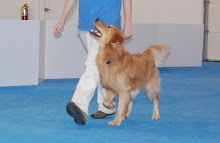What started as a short jump-tunnel sequence ended up being a lot of thought on how a dog knows when reinforcement is available.
During the session, the young retriever was bouncing at his handler and then running off to get into trouble. He wanted the reinforcers, but did not seem to know how to get them.
For Griffin, he is to get treats if I deliver it to his mouth (as opposed to him lunging forward to take it), if I cue "get it" and toss or drop or present, or if I hold my hand in one of two "come get it" ways. Anything else? And there is no chance he will get it and he shouldn't try. We have similar rules for toys.
This allows us a -lot- of freedom that more beginner dogs don't have. I can have food visible and works without being distracted by it. The food can be on the ground and accessible and he will perform his task. My preparing/moving reinforcers are not disrupting our training.
How did we resolve the challenge with the retriever in class? We determined that the owner did have some rules in place about when reinforcers were (or were not) available. We had to make those rules intentional, with conscious decision, and we had to fine tune a few areas where the rules were vague.
Then, after our planning, we had to do some training to teach the dog the difference between accessible and inaccessible reinforcement. With most beginner dogs this isn't necessary, but he had learned that there were "sometimes accessible" cues and to try and get the food at those times.
I'll be interested to see what his handler says next week after another week to think about it.
Here's a video that I really like....showing how a group of sharks knows when reinforcement is available.
http://dsc.discovery.com/videos/shark-week-training-a-shark.html
Tuesday, September 6, 2011
Subscribe to:
Post Comments (Atom)




No comments:
Post a Comment